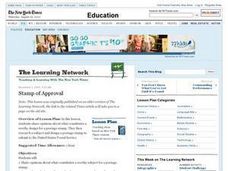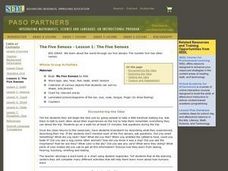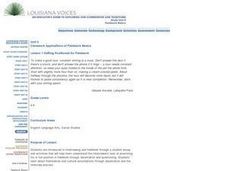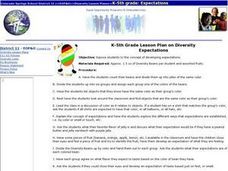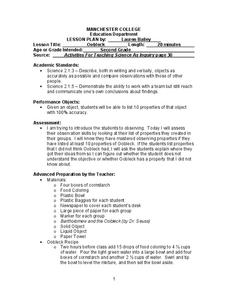Curated OER
What is That White Stuff?
Fifth graders identify, through experimentation, what properties of substance are, determine what variables tested will be, identify constants and variables of experiment, conduct experiment to conclusion with measurable, recorded...
Curated OER
Sharks: Fact or Fiction
Second graders discover the truth about sharks. In this shark lesson, 2nd graders use different resources to help distinguish between fact and fiction with what they have heard about sharks. They complete an attached activity sheet.
Curated OER
Stamp of Approval
Students share opinions about what constitutes a worthy design for a postage stamp. They research a subject and design a postage stamp to submit to the United States Postal Service.
Curated OER
Introduction to Trees and Wood
Students examine samples from various types of trees. In this trees and wood instructional activity, students review The Giving Tree and complete a KWL chart on trees. Students brainstorm what we get from trees and view wood samples...
Curated OER
Let's Learn about Symmetry
Students explore symmetry in architecture. In this cross curriculum art and architecture lesson plan, students fold paper to illustrate symmetry and identify symmetrical and asymmetrical shapes. Students observe photographs or take a...
Curated OER
Creating AB Patterns
Students work with patterns. In this pattern lesson, students find AB patterns in nature and the manmade world. They create their own AB pattern using math manipulatives and visual arts.
Curated OER
The Five Senses - Barefoot Walking Trip
Students go outside and take a little barefoot walking trip. They talk to each other about their experiences on the trip to help them remember everything they can. They go on a walk for at least 15 minutes. Ask questions during the trip.
Curated OER
Measuring Up on the Mayflower
Second graders use a meter tape to compare the length of the Mayflower to a basketball court and make homemade butter for crackers. Afterward, all students sit inside the makeshift Mayflower's dimensions and enjoy their Pilgrim butter.
Curated OER
Earthquakes
Fifth graders explore the causes of earthquakes and the various types of fault lines through a variety of hands-on demonstrations using prepared cakes. They record their observations in their science journals.
Curated OER
Lost Treasures of Tibet: Mandalas
Students examine the history of mandalas from Tibet. After reviewing the Designing a Mandala handout, they use geometric symmetrical shapes to create their own examples. Next, they write poems or essays and explain the meaning of the...
Curated OER
Three States of Matter
Third graders investigate the three states of matter and the properties of materials as they undergo physical changes. They identify examples of each type of matter, role-play atoms in solids, liquids, and gases, and conduct an...
Curated OER
Farm Mobile
Second graders are given a variety of materials to communicate the symbols of farm life. They create a mobile utilizing the given materials depicting farm life and following step-by-step instructions correctly. Students also read the...
Curated OER
Combating Corrosion
Students perform an experiment to show the chemical reactions that occur when metal corrodes. They apply the results of the experiment to the conservation efforts of art curators trying to restore an ancient Greek bronze. This lesson...
Curated OER
Getting Positioned for Fieldwork
Students examine interviewing and fieldwork through a student essay and activities that help them understand the interviewer's task of examining his or her position in fieldwork through observation and questioning. They explore cultural...
Curated OER
Creating Coacervates
High schoolers create and observe coacervates. In this origin of life lesson, students create coacervates by mixing carbohydrate and protein solutions. They observe the life-like qualities of the structures and discuss the origin of life.
Curated OER
Historical Events of the Civil War
Fifth graders research the Civil War through the use of primary documents. In this historical events of the Civil War lesson, 5th graders write about the information gotten from the primary document. Students answer critical thinking...
Curated OER
Breaking the Chains, Rising out of Circumstances
Students research, write, and draw about Roman versus American slavery. In this slavery lesson plan, students look at the Roman portraits of slaves, its influence on Western European art, and compare Roman slavery to American slavery.
Curated OER
18th Century Microscope
Students examine a microscope from the 18th century. In this microscope lesson, students investigate how it works, what it was used for and how the tool has evolved through the years. Students also build knowledge on how compound...
Curated OER
Diversity Expectations
Students categorize different items into categories of characteristics to demonstrate diversity. In this diversity lesson plan, students then relate the items to people and their diversity.
Curated OER
A More Perfect Product
Learners participate in a discussion about the basics of house design including the influence of site, materials, function, form and style. They explore these concepts by creating a floor plan and conceptual drawing of a house.
Curated OER
Apples A Peel To Me
First graders gather, record and interpret data. In this math lesson plan, 1st graders collect data from their classmates regarding their favorite types of apples. Students use the data collected to explore the use of real graphs and...
Curated OER
Oobleck
Second graders observe the properties of Oobleck. In this science and observation instructional activity, 2nd graders examine Oobleck and make a list of 10 properties that they notice. They explain their observations.
Curated OER
Patterns and Paper Weaving
Students weave construction paper to create a placemat that displays a pattern.
Curated OER
A Guide (on the Side) to Physics
Students engage in a lesson that is concerned with the concepts related to the study of Physics. They participate in class discussion and list common misconceptions of Physics. Students write and discuss the problem of Science illiteracy.




